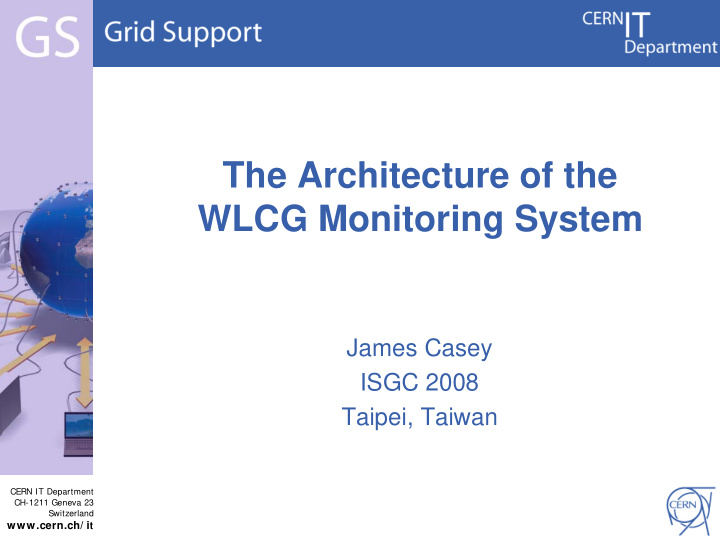



The Architecture of the WLCG Monitoring System James Casey ISGC 2008 Taipei, Taiwan CERN IT Department CH-1211 Geneva 23 Switzerland www.cern.ch/ i t
Outline • WLCG Monitoring Working Group • Technology investigation – Messaging system – Reporting tools • Prototypes – Site Monitoring • Example – OSG RSV publication • Summary Internet Services CERN IT Department CH-1211 Genève 23 2 Switzerland www.cern.ch/ i t
WLCG Monitoring Working Group • The WLCG Monitoring working group has the mandate to “….help improve the reliability of the grid infrastructure….” “…. provide stakeholders with views of the infrastructure allowing them to understand the current and historical status of the service. …” “… stakeholder are site administrators, grid service managers and operations, VOs, Grid Project Internet management” Services CERN IT Department CH-1211 Genève 23 3 Switzerland www.cern.ch/ i t
Process • Review existing monitoring systems • Identify gaps • Prototype some solutions • Design integrated architecture for monitoring “Improving reliability is our goal !” Internet Services CERN IT Department CH-1211 Genève 23 4 Switzerland www.cern.ch/ i t
The pieces to work with… • The starting point was what we have now: – Availability testing framework – SAM/RSV – Job and Data reliability monitoring – Gridview – Grid topology – GOCDB/Registration DB – Dynamic view of the grid – BDII/CeMon – Accounting – APEL/Gratia – Experiment views – Dashboards – Fabric monitoring – Nagios, LEMON, … – Grid operations tools – CIC Portal • They work together right now Internet Services – To a certain extent ! CERN IT Department CH-1211 Genève 23 5 Switzerland www.cern.ch/ i t
We’ve got an integration problem ! Internet Services CERN IT Department CH-1211 Genève 23 6 Switzerland www.cern.ch/ i t
Messaging systems for integration • We need: – Loose coupling of systems – Distributed components – Reliable delivery of messages – Standard methods of communication – Flexibility to add new producers and consumers of the information without having to reconfigure everything • Message Oriented Middleware provides this – And is widely used in similar scenarios Internet Services CERN IT Department CH-1211 Genève 23 7 Switzerland www.cern.ch/ i t
Broker at the centre .. Reliablity and persistence of messaging built into the broker network Mitigates the single point of failures we’ve had Internet with previous solutions Services CERN IT Department Message delivery is guaranteed CH-1211 Genève 23 8 Switzerland www.cern.ch/ i t
… or some of them… • Not a silver bullet – Still can end up with spaghetti • Tight specification of interaction of components is required – Message format specifications – Standard metadata schema – Message Queue naming schemas – Protocols • Standard “Patterns” can act as a basis for most of this Internet Services http://enterpriseintegrationpatterns.com/ CERN IT Department CH-1211 Genève 23 9 Switzerland www.cern.ch/ i t
Reporting for WLCG • Currently a post-processing of results and graphs in Excel – Much manual work needed ! • Try to implement it directly on the GridView DB • Using a mature open-source reporting toolkit – JasperReports – UI Report builder – iReports – Web-based report server - OpenReports Internet Services CERN IT Department CH-1211 Genève 23 WLCG Monitoring – some worked examples - 10 Switzerland www.cern.ch/ i t
JasperReports Internet Services CERN IT Department CH-1211 Genève 23 WLCG Monitoring – some worked examples - 11 Switzerland www.cern.ch/ i t
Site Monitoring & Nagios • More details in next talk: – “ Simply monitor a grid site with Nagios” • Nagios has shown itself to be a very useful component for building many part of our monitoring solutions – Local Site monitoring – Replacing the SAM execution framework – gStat – BDII monitoring • Probes within Nagios • Publish site results upwards to be part of Internet availability/reliability computation Services CERN IT Department CH-1211 Genève 23 12 Switzerland www.cern.ch/ i t
Messaging based archiving and reporting Internet Services CERN IT Department CH-1211 Genève 23 13 Switzerland www.cern.ch/ i t
In Production - OSG RSV to SAM • RSV – Resource and Service Validation – Uses Gratia as native transport within OSG – And OSG GOC runs a bridge to SAM for WLCG Internet Services CERN IT Department CH-1211 Genève 23 14 Switzerland www.cern.ch/ i t
Strategy Summary • Converge to standards, but without a big bang • Leverage the underlying infrastructures rather than layer lots of systems on top • Reduce maintenance/development costs by using commodity components whenever possible • Modular and loosely-coupled to adapt to changes in infrastructure and funding models Internet Services CERN IT Department CH-1211 Genève 23 15 Switzerland www.cern.ch/ i t
Architecture • Our design for a new architecture leverages commodity software components – Probe Execution (Nagios), Messaging (ActiveMQ), Reporting (JasperReports) • It is essentially an integration exercise – Make existing tools work together better • In order to improve reliability – This is what we will verify over the next 12 months Internet Services CERN IT Department CH-1211 Genève 23 16 Switzerland www.cern.ch/ i t
Recommend
More recommend